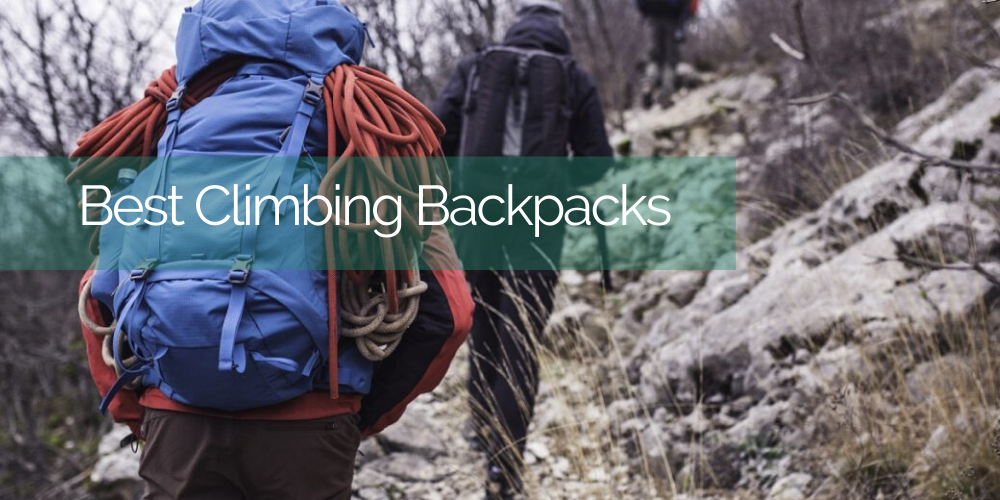The best climbing backpacks add to the climber’s ability to get through his climb, whether it be in the gym or in the outdoors, as efficiently and safely as possible.
When looking for your climbing backpack, you will need to make sure you consider a couple of different styles and features of backpacks to find which fit you the best and will help with your specific climbs.
5 of the Most Versatile Climbing Backpacks
Nevo Rhino 45L Hiking Backpack, Expandable
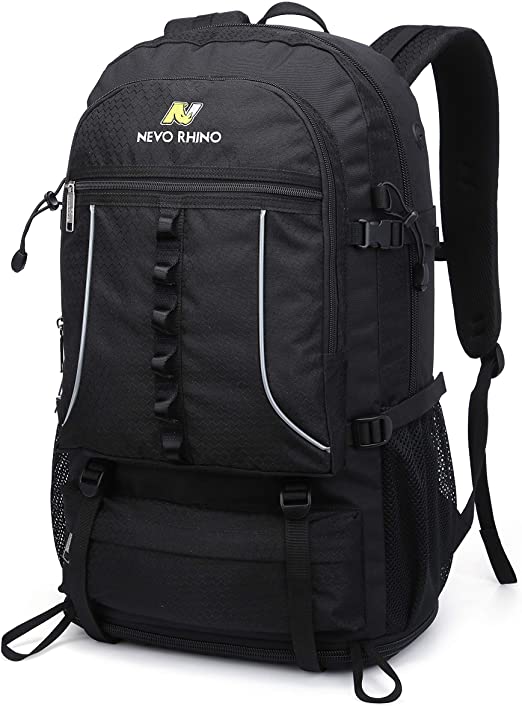
The Nevo Rhino is a super great option for your climbing adventure. One of the biggest concerns for a backpack while you are climbing is the weight versus capacity. It is frustrating to have a large, heavy climbing backpack weigh you down. However, it is just as frustrating to have a tiny pack that won’t hold much gear.
Here are all of the adjustable parts of the Rhino.
- Length at the bottom
- Waist straps
The Rhino is an adjustable backpack. The expansion happens at the zipper portion of the pack located at the bottom. It goes from 21.65” inches to 25.61” inches long. This deeper capacity gives you the ability to decide what kind of climb you will have.
The waist straps are actually adjustable. The longer you are on the cliff face, the more your waist straps will become more comfortable. Being able to loosen or tighten the straps will definitely give you an advantage on your climb.
Waterproof
It’s also waterproof, so that your precious gear, food, and other items won’t get soaked from a sudden downpour. Also, once you reach your destination you won’t have to worry where you set it down, in or out of shallow water.
It is made out of heavy duty ripstop polyester. This is environmentally friendly while being extremely durable.
Mesh padding is stitched into the fabric of this climbing backpack. This will decrease its weight and also be able to keep you from getting too hot on your climb. Along with its fabric, the shape is designed to be ergonomic to your body, allowing for better weight distribution.
Affordable
The bag is pretty budget friendly as well. It has good durability and a lightweight fit which will compare to much higher priced climbing backpacks.
It also has a great assortment of hooks and cables, perfect for hanging climbing gear items from and increasing the versatility of the pack.
Lack of Frame
A flaw in this backpack is its lack of frame. This is an advantage if you are looking for compressibility, but the lack of the frame will make the backpack hang to one side or the other unless perfectly packed.
Pros
- Great compression
- Extendable
Cons
- No frame
Venture Pal Packable Lightweight Backpack
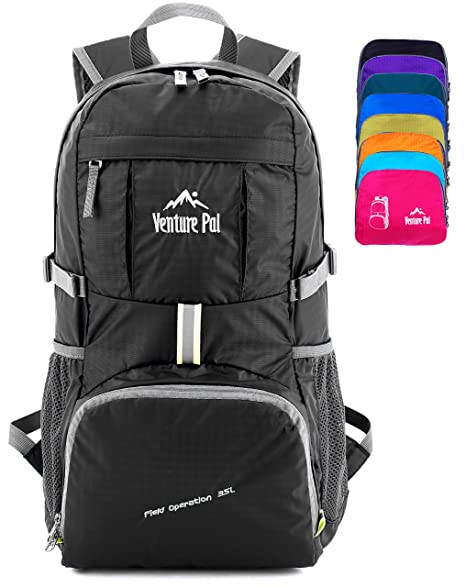
The Venture is a great pack for durability. Ant-rip and tear material gives you the ability to go on harsher climbs.
Two way zippers are a great asset to give you that much more ease of use on your climb. No matter what side you want to zip or unzip, you can get it done.
The shoulder straps are padded to give you more comfort on a long climb. Its chest straps are adjustable and there is a strong buckle holding it in place, this way your pack can be more secure.
There are about five pockets on this backpack of varying size. The main compartment is large enough to hold a water bag, and the other pockets are medium to small in size, perfect for your variety of climbing items.
Foldability
A unique feature of this climbing bag is that it can actually be folded up into itself. This compression ability is really great for versatility. This way you don’t have to lug around a full length backpack if you don’t need it for the moment.
Thin walls of the pack are helpful when you are on a climb where you don’t have much room. When squeezing through crags and sliding past openings with little room to spare, this backpack won’t be the thing adding to your difficulty.
Thin Walls
Though the thin walls are a plus for small spacing, the thinness does present an abrasion problem. Too many harsh climbs and undue stress may cause tears in the climbing backpack.
Another flaw in this pack is that it claims to be waterproof, however this is not a totally accurate claim. It does keep a good amount of water out for a time, but after much wear and tear from other elements, such as heat, abrasion, etc., the waterproof layering that is built into the pack begins to peel off after a while.
Pros
- Lightweight
- Able to fold into itself
Cons
- Waterproof
- Thin material
Black diamond bullet
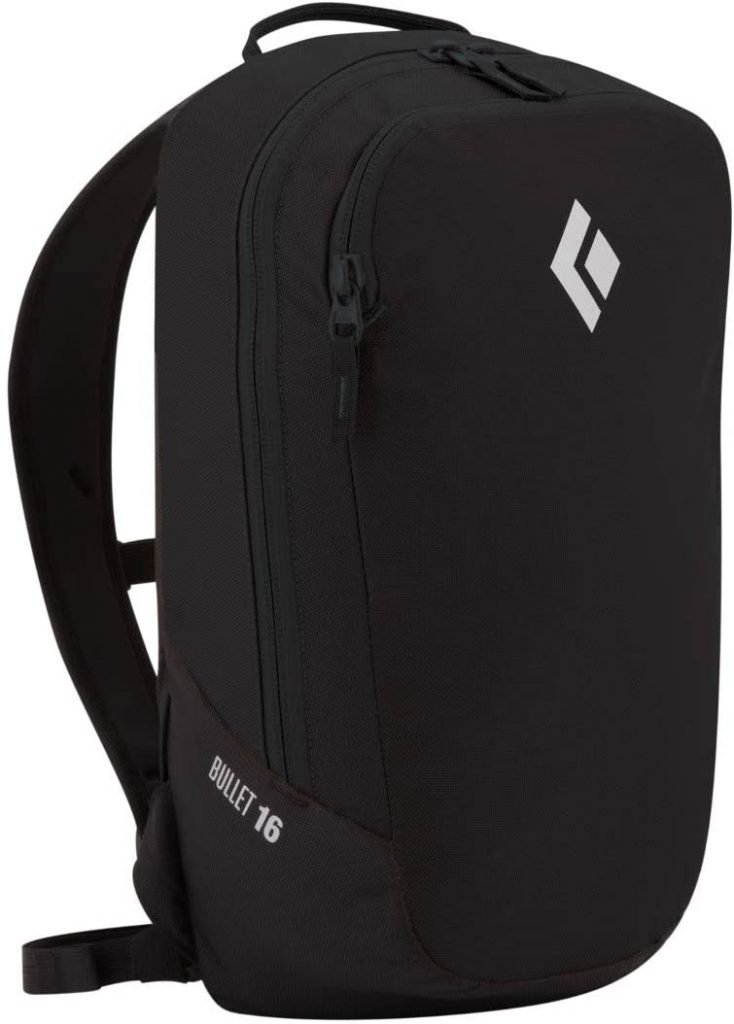
Foam Panel Backing
The unique feature of the Black Diamond bullet is its removable foam backing. If you are going on a shorter rock climbing mission you may not need as much comfort, and the removability means you can fit more gear, food, items, etc. into this bag without the foam.
However, with the foam back panel, this pack provides a lot of comfort while being lightweight as well. A webbed hip belt adds to this comfort and the contoured shoulder straps make keeping your backpack in place even easier.
Though a smaller climbing back than others, it can still fit essentials such as a rope, food, a guide book, water bottle, and an extra pair of shoes very well.
No Gear Loops
The downside to this climbing backpack is the lack of having loops or slips that usually protrude out from the backpack. This would allow for a larger amount of gear to be carried or a varying array of items. Larger bulkier items could be stored inside, and smaller, more awkward items on the hanging loops.
However, despite not having hooks or loops makes this climbing backpack very sleek and compact.
Bladder Storage
The Bullet also features a compartment on the inside that is specifically used to store a hydration bladder. A 2-liter hydration bladder should fit into this inside compartment. But some hydration bladders are too bulky to fit into this particular compartment.
This climbing backpack could definitely be used on a single pitch climbing journey, and possibly on a multi-pitch climb, but a short one.
Its greatest feature is that it is not totally decked out with bulky features that you may not really need. Its simple design and a pretty middling carrying capacity is its biggest draw.
Pros
- Sleek
- Compact
Cons
- No gear loops
Outlander Packable Lightweight Travel Hiking Backpack Daypack
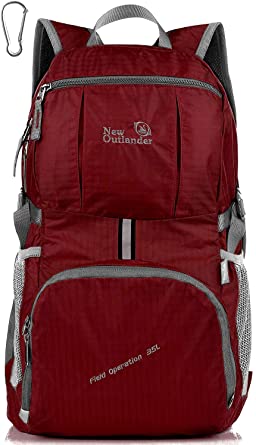
Sturdy Material
Nylon fabric makes up the material of the sturdy Outlander climbing backpack. It is a great rip resistant fabric while also being water resistant.
All the highest stress on the backpack is reinforced by bar tacking. Most climbing backpacks have very study fibers at their stress points, but it is a definite advantage that these are doubly reinforced.
Also, it can fold into itself when it’s not in use. This is a huge bonus that will definitely help with compactness on your trail.
Lightweight
At 0.7 pounds it is a really great choice when worried about weight being added to your climb. When you have lots of items to carry during your climb, the last piece of equipment you want weighing you down is your actual climbing backpack.
The Outlander has five pockets, and a bonus is that the two side pockets are large enough to store a small umbrella or most moderately sized water bottles.
A carabiner clip is also featured on this backpack so that you can hang extra equipment. Some lightweight packs don’t have any extra clips in order to increase their compactness and low weight, so it is a definite plus that this includes a carabiner clip.
Weak Water Resistant Lining
Great as it is, there are a couple of flaws with this climbing backpack. The inner lining has been known to wear out after long continuous use. This is part of the water resistant feature. This may not be the best long term climbing pack if you are worried about its water resistant holding up.
Another downside is that the pack is better for fitting a lot of items, but not so much for fitting more weight. You may want to determine your lightest items and pack your climbing backpack accordingly.
Pros
- Folds into itself
Cons
- Inner lining deterioration
Black Diamond Street Creek 24 Backpack
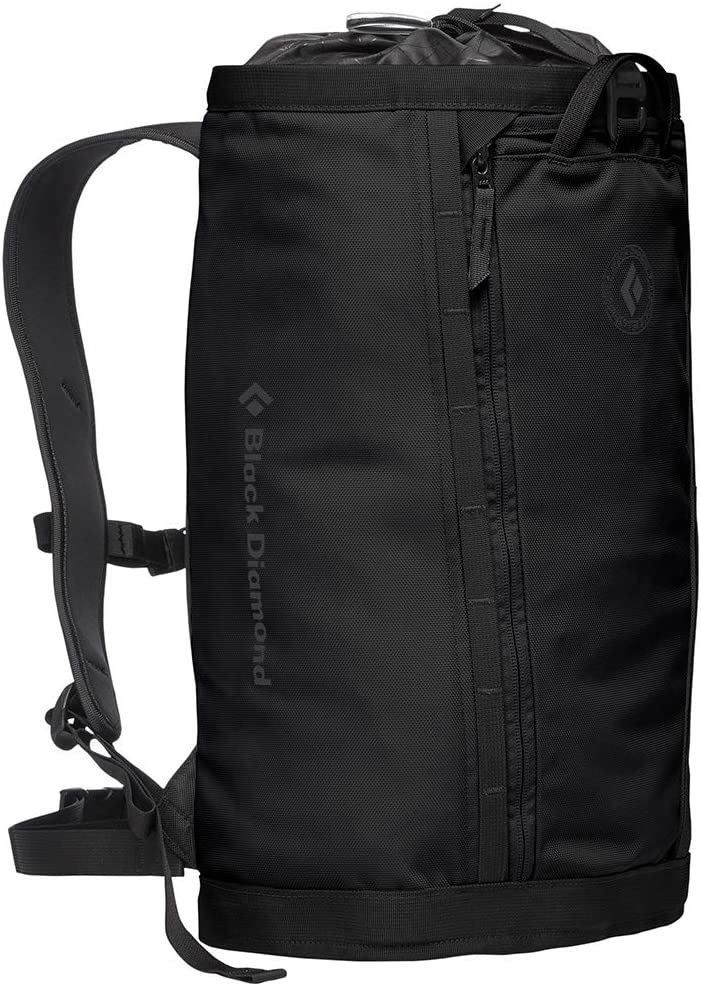
Very Roomy
This version of the Black Diamond Street Creek climbing backpack is designed as more of a haul bag. The top is closed by a drawstring method and there is a large zippered compartment at the front.
Since it is designed as a haul bag style and has a drawstring closure instead of a zipper at the top, you can stuff more items into as the drawstring will tighten over the items better than a normal zipper. It also has a rain cover to keep your effects dry when you get hit with sudden showers.
Lots of Pockets and Loops for Gear
Here are all the ways you can carry extra gear in the street creek.
- Internal pockets
- External Pockets
- Climbing rope straps
- Laptop sleeve
The internal pockets are great for holding smaller items that you want kept separate from the rest of your climbing gear such as phones, watches, etc.
You can carry your climbing ropes on top of the bag as it has a dedicated strap for just that purpose. Obviously this feature can be used to hold in place a variety of items and also to hang gear from with carabiners as well.
A dedicated laptop sleeve is included with this bag, making it very versatile. You can use this while bouldering or crag climbing, or you can take it to work. The finish is smooth and slick so that dirt or chalk from your climb can easily be wiped or washed off and won’t interfere with the clean look of your pack if you are taking it to work. ‘
Not Much Padding
Shoulder and waist are all adjustable. However they are a little thin and unpadded, so if you are carrying heavier equipment or climbing for.a longer period of time they may become uncomfortable.
Pros
- Drawstring closure
- Versatile
Cons
- Opening exposed to rain
How to Choose the Best Climbing Holds
Look out for several key factors when you are buying your climbing backpack. The best climbing backpacks all have standard must haves that will make your climb much easier and enjoyable.
However not all features are necessary for you. You may prefer gym climbing more than crag climbing, so certain features that benefit the kind of climb they are not often on may not be important to you.
However, knowing a few standards the all the best climbing backpacks will definitely be a plus before choosing the one you will get.
Size
This is a huge feature to consider when you are looking for the right climbing backpack. Depending on the climb, you will be carrying your pack for a large portion of your journey, so you will have to settle on a weight that fits what you will be doing.
Multi-pitch climbs may require a good deal more equipment than a single pitch. However, lugging a huge backpack around, especially while hanging from the side of a cliff will not be enjoyable.
The reverse is true for a small backpack. You may not get as far as you would like on your climb with a small backpack, as the less gear you have will affect your ability to climb for longer periods of time.
Comfort
Since most of your gear will be sitting in your backpack, the likelihood of the pack becoming increasingly uncomfortable is very high. Of course you will be able to hang equipment from your harness as well, but a good deal of your items will be held in the backpack.
If your straps around your arms and waistband don’t have enough padding on them, these will be the first sore points after a while of climbing.
But if you have too much padding on your climbing backpack, your breathability will go down and you may overheat more quickly.
Durability
The material you pack is made with is important for the longevity and abrasion resistance of your backpack. You will want materials that are blended, but also not too thick because breathability will affect each climb.
But the thicker the material the stronger it will be when it comes in contact with harsh rock or heat, wind, and water damage.
The Best Questions About Climbing Holds
Q: Can I use my climbing backpack anywhere?
A: Yes, but you may want to use it sparingly as the main place that you will want it to hold up is on your climb.
Q: How big should my climbing backpack be?
A: It should be large enough to accommodate necessary equipment, but not big enough that it will hinder your climb, as in it shouldn’t weigh very much by itself unless you need a larger backpack for a multi pitch climb.
Q: Why do I need a climbing backpack? Can’t I just use a normal backpack?
A: Generally, climbing backpacks are made to be breathable, durable, and compact. These are all things that help you be able to wear it for longer than you would a normal backpack, take it into environments where it will hold up much better, and utilize the least amount of space.

